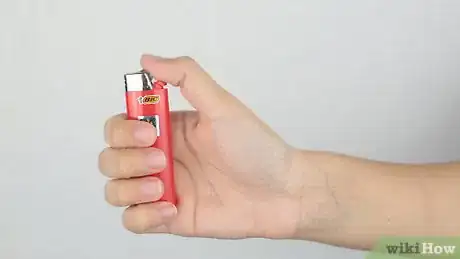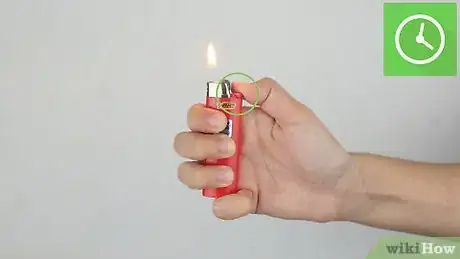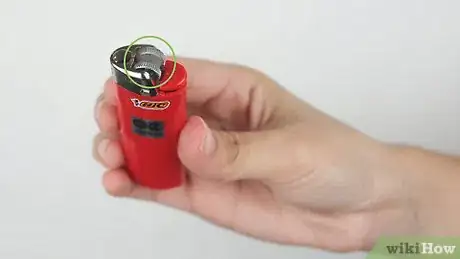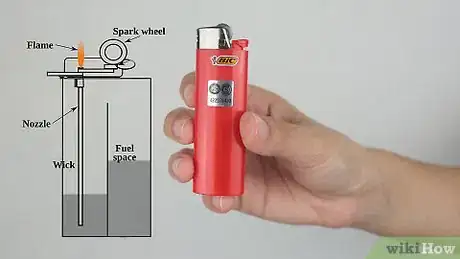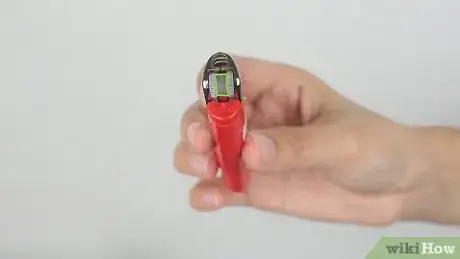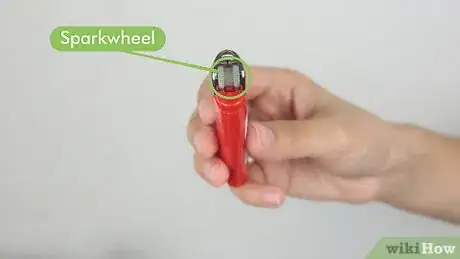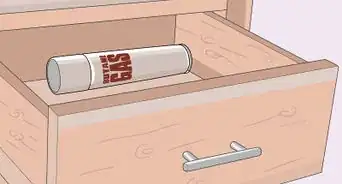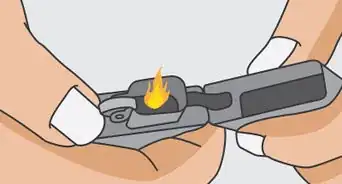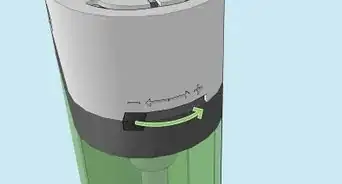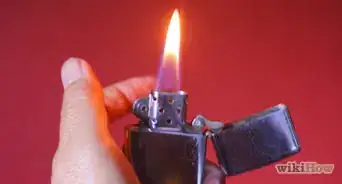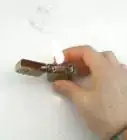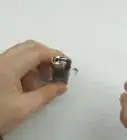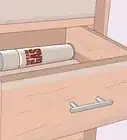This article was co-authored by wikiHow Staff. Our trained team of editors and researchers validate articles for accuracy and comprehensiveness. wikiHow's Content Management Team carefully monitors the work from our editorial staff to ensure that each article is backed by trusted research and meets our high quality standards.
This article has been viewed 597,982 times.
Learn more...
Flicking a Bic lighter is easy once you get the hang of it. Use your thumb to roll the metal spark wheel down toward the red ignition button. Hold down the button to release gas. When you "flick" the wheel, you will generate a spark that ignites the gas. Look for the immediate flame. Keep holding the button as long as you want to keep the flame going.
Steps
Flicking a Bic
-
1Hold the lighter upright in your dominant hand. Curl your fingers around the body of the Bic to keep it steady. Rest the edge of your thumb on the red button so that it is touching the serrated metal sparkwheel. Find a grip that feels comfortable. You may need to experiment with your thumb at several angles before you get it right.[1]
- This red button is the ignition button that releases the gas from the lighter chamber.
- Grip the lighter at least half an inch below the metal portion. The metal gets really hot and you're also more likely to get burned the closer you are to it.
-
2Roll the metal sparkwheel down into the red ignition button. Use your thumb. Apply some force to the wheel, as you push it downward, to ensure that you create a spark. Turn the sparkwheel in one quick, decisive motion. If you do it right, a flame come out from the top of the lighter.
- You won't see the spark. The spark is generated inside the metal housing of the lighter.
Advertisement -
3Hold the red button to keep the flame going. After you roll the sparkwheel, your thumbnail should rest firmly on the button. As long as you hold this tab, you are releasing a steady stream of gas from the inner chamber of the lighter. The gas feeds the flame and keeps it burning evenly. As soon as you release the button, the flame will cease.
- Don't keep the lighter lit for more than 30 seconds. Let off the gas right after you light the object that you're trying to light. The top of the lighter will get hot rather quickly, which can be dangerous.
- To get maximum life from your lighter, avoid burning it for any longer than necessary. Most lighters come with plenty of flint to outlast the fuel in normal use, so it is better to relight it than to keep it burning between tasks: e.g. lighting a great many candles. It's unlikely that the flint will run out before the fuel does. When it does run out of gas, you're out of luck.
Understanding the Mechanism
-
1Find the sparkwheel. This serrated metal wheel, also called the striker, is the part of the lighter that creates a spark. When you roll the wheel down into the lighter chamber, it strikes against a piece of flint. The resultant spark ignites the gas from the fuel well, creating a small, steady flame.
-
2Know the function of the ignition button. The red ignition button, when pressed, releases the gas valve to the fuel tank. In order to light the lighter, you'll need to strike the sparkwheel and hold the ignition button at the exact same time.
-
3Envision how the lighter works. When you spin the wheel, you make a spark. When you hold the button, you release a steady stream of gas. When you do to the two at the same time, the spark ignites the gas and sends a small flame through the hole at the top of the lighter. The flame will keep burning for as long as you hold the button.
Troubleshooting
-
1Keep trying. If you are using a relatively new Bic lighter, the problem likely lies with your technique rather than with some malfunction within the tool. Work on your hand placement. Make sure that you are striking the spark wheel quickly and powerfully enough to generate a spark. Check that you are holding down the ignition button and not just letting it go.
- Bic lighters should still work in somewhat rainy and windy conditions. If you are having trouble flicking the Bic, however, try cupping the lighter with your hand or otherwise blocking the wind so that it cannot steal away the flame. Create a dry space with still air.
-
2Consider removing the safety band. This will make the lighter somewhat less "safe," but it will make it easier to light. You won't need to apply so much force to create a spark. Many Bic owners make a practice of removing the safety band as soon as they buy a new lighter.[2]
-
3Check the fuel level. If the lighter doesn't light, check to make sure that there is fuel in the tank. It will be obvious with a transparent lighter. Hold an opaque lighter up to a light source. With a darker colored lighter, hold the top some distance away from your ear and tap it a few times. Keep your thumb on the lever and away from the striker wheel so you don't set your head on fire. You should hear a fairly strong hiss.
- If the lighter is out of fuel, throw it away. Disposable lighters are not meant to be refilled.
- You should be able to get up to 3,000 lights from a full-sized Bic lighter.
-
4Have a look at the striker or "sparkwheel." If the lighter has fuel but still doesn't light, then the problem may be with the striker. Cheap lighters and Bics that have been used extensively will fail after a while because, while it still produces a visible spark, it's not dense enough to light the butane.
- If the Bic is still producing a spark, you can hold the striker wheel down hard and very slowly turn it, grinding a little bit of flint off the stick. When the striker is hit full force, it should scatter and ignite the flint, which should be enough to light the butane. Be careful: the bits of flint can scatter and land on skin or clothing. The likelihood of burning yourself is very small, but still existent.
- If the striker produces no spark at all but there is still butane in the tank: put the tips of two lighters together. Hold down the ignition button of the first lighter to release fuel. Then, use the striker from the other, functioning lighter (possibly one that has run out of fuel) to light the first.
Warnings
- Be wary of "lighter tricks." Not all "painless" tricks on YouTube are actually pain-free. Take all YouTube advice with a grain of salt.⧼thumbs_response⧽
- Never hold your lighter on the metal portion after you've lit it. You may burn your hand.[3]⧼thumbs_response⧽
References
About This Article
To flick a Bic lighter, hold the lighter upright in your dominant hand. Use your thumb to quickly and firmly roll the metal spark wheel down onto the ignition button. You may need to do this a few times to get the lighter to light. Once the flame ignites, hold the ignition button down with your thumb to keep it going. To save the gas inside and keep the top of the lighter from overheating, don’t hold the button down for more than 30 seconds at a time. To learn more about how a Bic lighter works, keep reading!
